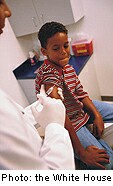
TUESDAY, Dec. 22 (HealthDay News) — The good news on the H1N1 swine flu front is that the number of cases of infection continues to decrease and the vaccine supply is now plentiful.
The discouraging news is that too few people are getting inoculated, a top U.S. health official said Tuesday.
“The H1N1 vaccine supply is getting better and better,” Dr. Anne Schuchat, director of the U.S. Centers for Disease Control and Prevention’s National Center for Immunization and Respiratory Diseases, said during an afternoon press conference.
While cases of swine flu infection continue to diminish around the country, the H1N1 virus is still the dominant flu strain, Schuchat said. “Disease is at a better state around the country, less virus is circulating,” she said. “But still everything we are seeing in terms of the flu strains is the H1N1 virus. So it’s not gone at all.”
There’s no way to predict whether there will be a resurgence of swine flu, which peaked nationwide in early November with 48 states reporting widespread activity.
So, “it is important to not become complacent about the ongoing risk of H1N1 influenza,” Schuchat stated.
Schuchat said an estimated 111 million doses of H1N1 vaccine have been distributed so far. A CDC survey done two weeks ago found that about 46 million people had received the vaccine, with approximately 40 percent of the doses going to children, she said.
“Coverage was about twice as high in children as it was in adults,” she said. “That’s really good news because usually with seasonal flu there’s a lot more vaccination of adults, including seniors, than children. But with the H1N1 vaccine we were targeting children because they have been so hard hit by the virus.”
Unlike seasonal flu, which typically poses a much bigger threat to people aged 65 and older, the swine flu has been targeting children and young adults, probably because they have little or no immunity to the H1N1 virus, which was last seen on a pandemic level more than 50 years ago.
In a possible response to the drop in swine flu cases nationwide, a new Harvard poll found that only 40 percent of those surveyed were concerned that they or their family would come down with the flu. In a September poll, 52 percent were worried.
The poll also found that by Dec. 17, about 56 million people — more likely children than adults — had received the H1N1 vaccine.
“Taking those two data points together, we think right now probably at least 60 million people have been vaccinated with the H1N1 vaccine,” Schuchat said.
Now is a good time to get vaccinated against the H1N1 flu, she said, because supplies are plentiful. And should there be another wave of illness, you’d be protected.
Schuchat also said that children under 10 years of age should get two doses of the vaccine to be fully protected. A recent article in the Journal of the American Medical Association suggested that children might need only one dose.
“If you have children who are under 10 years of age that have gotten the H1N1 vaccine, it is important to know that your child needs a second dose,” she said. “We recommend two doses of H1N1 vaccine about one month apart.”
According to CDC estimates, children and young adults continue to be most vulnerable to the H1N1 flu. From mid-April, when the virus first surfaced, until November, 47 million Americans came down with the swine flu. About 16 million of those people were children under 18 years of age, and about 27 million were adults between 18 and 64.
During the same period, an estimated 9,820 people died, including 1,090 children aged 17 and younger, as well as 7,450 people aged 18 to 64, according to the CDC.
More information
For more on H1N1 swine flu, visit the U.S. Department of Health and Human Services.

